Ebola Outbreak Analysis: Applying the DPSEEA Framework Approach
VerifiedAdded on 2023/06/13
|12
|3181
|419
Report
AI Summary
This report provides an in-depth analysis of the Ebola outbreak using the DPSEEA framework developed by the World Health Organization (WHO). It examines the driving forces behind the outbreak, such as unsafe funeral practices and the interaction between humans and infected animals, particularly bats, in Guinea. The analysis covers the pressures stemming from poverty, inadequate healthcare systems, and environmental degradation. State changes due to increased human activity in forests, leading to exposure to the Ebola virus, are also explored, along with the resulting health effects. The report identifies gaps in the DPSEEA framework, particularly its failure to account for economic, political, and social influences. It also discusses Ebola management strategies, the roles of health agencies like the CDC, and suggestions for addressing gaps in current policies, highlighting the importance of community health workers and coordinated emergency response systems. The report concludes by emphasizing the need for a more holistic approach to managing vector-borne diseases.
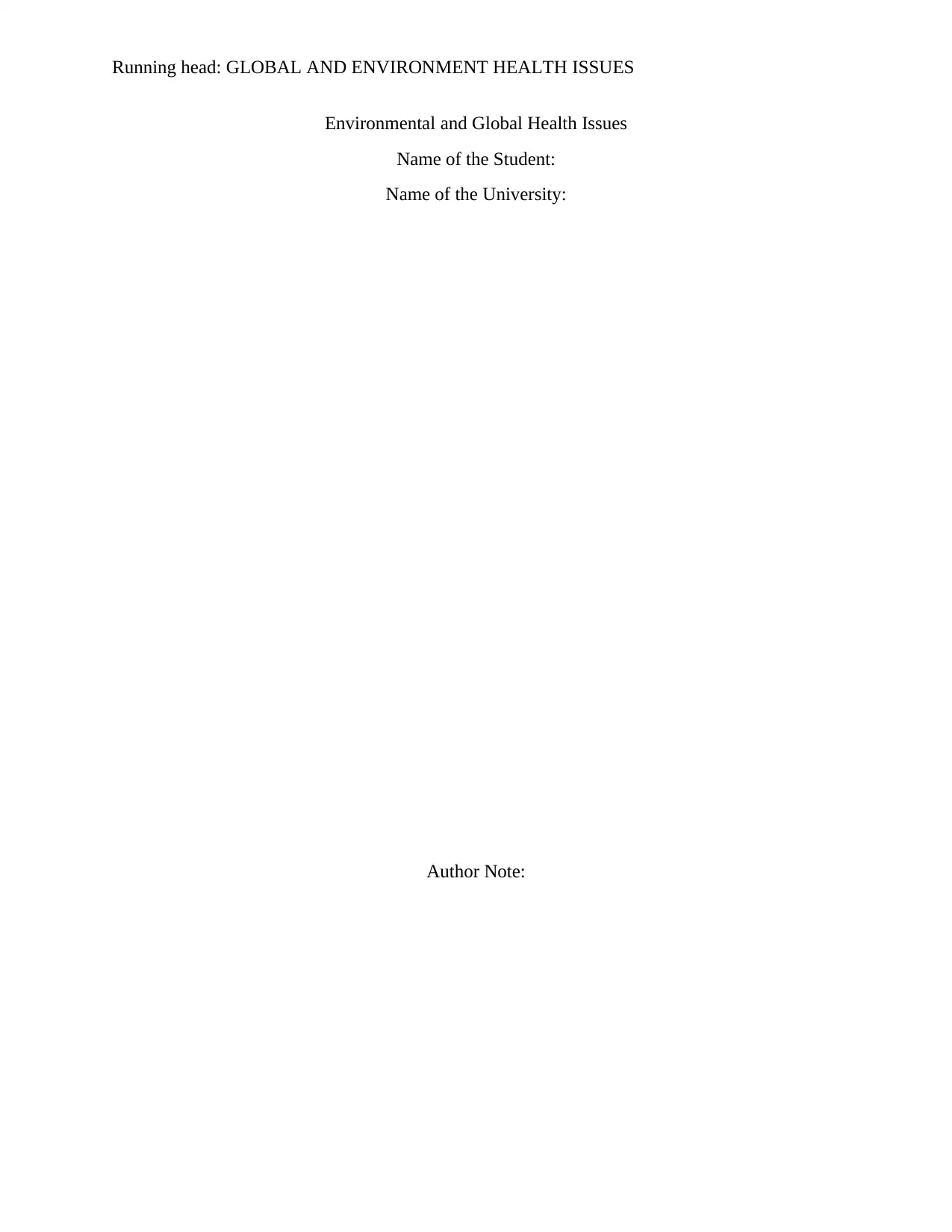
Running head: GLOBAL AND ENVIRONMENT HEALTH ISSUES
Environmental and Global Health Issues
Name of the Student:
Name of the University:
Author Note:
Environmental and Global Health Issues
Name of the Student:
Name of the University:
Author Note:
Paraphrase This Document
Need a fresh take? Get an instant paraphrase of this document with our AI Paraphraser
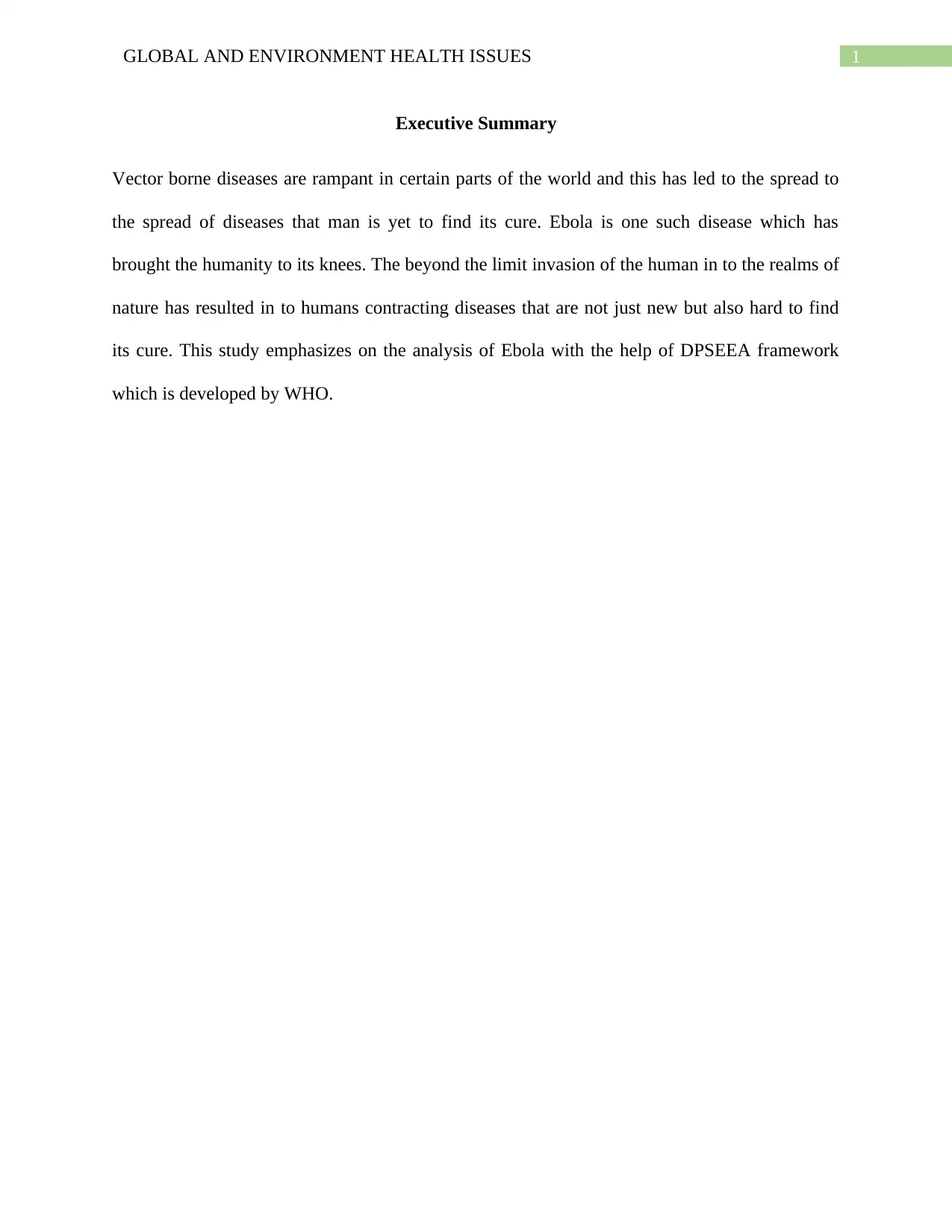
1GLOBAL AND ENVIRONMENT HEALTH ISSUES
Executive Summary
Vector borne diseases are rampant in certain parts of the world and this has led to the spread to
the spread of diseases that man is yet to find its cure. Ebola is one such disease which has
brought the humanity to its knees. The beyond the limit invasion of the human in to the realms of
nature has resulted in to humans contracting diseases that are not just new but also hard to find
its cure. This study emphasizes on the analysis of Ebola with the help of DPSEEA framework
which is developed by WHO.
Executive Summary
Vector borne diseases are rampant in certain parts of the world and this has led to the spread to
the spread of diseases that man is yet to find its cure. Ebola is one such disease which has
brought the humanity to its knees. The beyond the limit invasion of the human in to the realms of
nature has resulted in to humans contracting diseases that are not just new but also hard to find
its cure. This study emphasizes on the analysis of Ebola with the help of DPSEEA framework
which is developed by WHO.
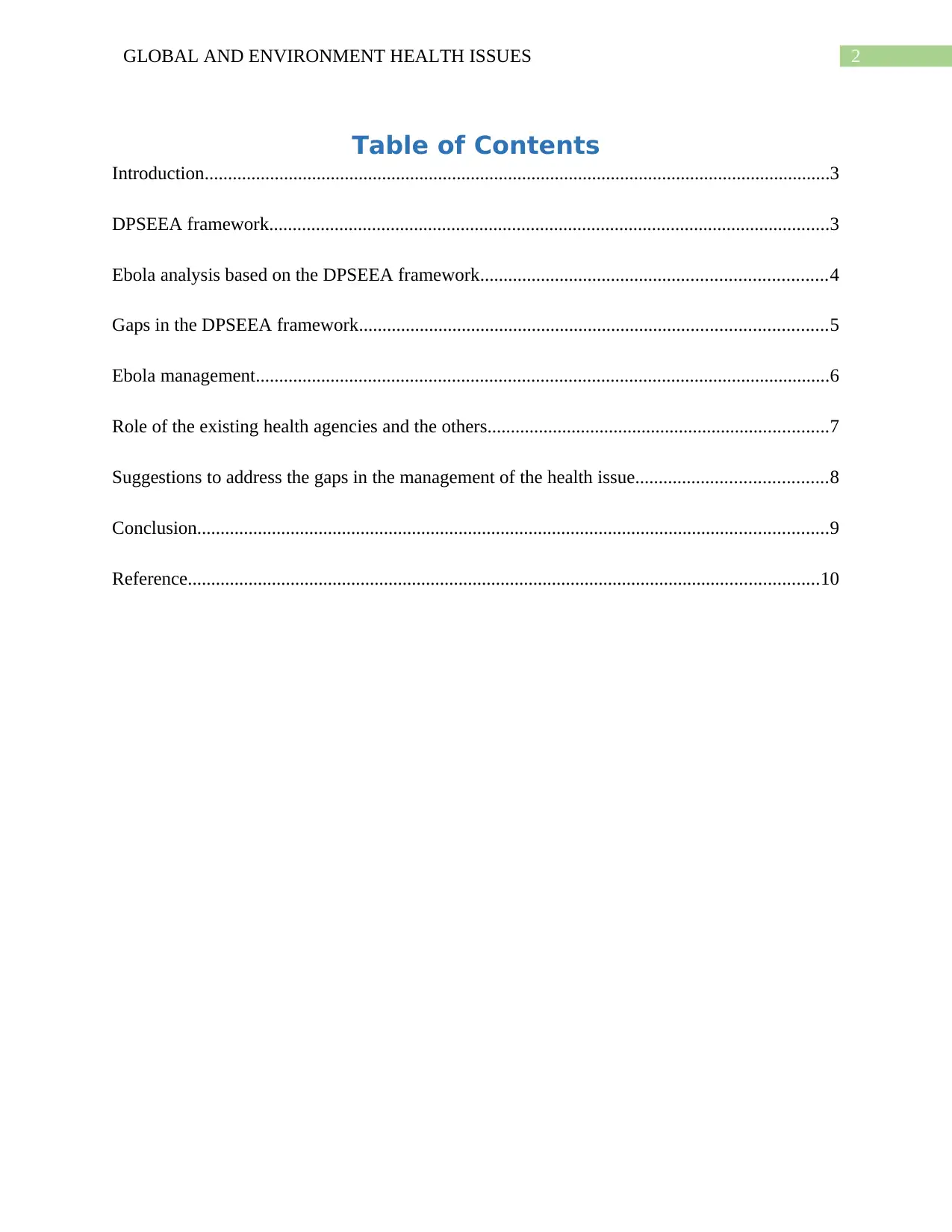
2GLOBAL AND ENVIRONMENT HEALTH ISSUES
Table of Contents
Introduction......................................................................................................................................3
DPSEEA framework........................................................................................................................3
Ebola analysis based on the DPSEEA framework..........................................................................4
Gaps in the DPSEEA framework....................................................................................................5
Ebola management...........................................................................................................................6
Role of the existing health agencies and the others.........................................................................7
Suggestions to address the gaps in the management of the health issue.........................................8
Conclusion.......................................................................................................................................9
Reference.......................................................................................................................................10
Table of Contents
Introduction......................................................................................................................................3
DPSEEA framework........................................................................................................................3
Ebola analysis based on the DPSEEA framework..........................................................................4
Gaps in the DPSEEA framework....................................................................................................5
Ebola management...........................................................................................................................6
Role of the existing health agencies and the others.........................................................................7
Suggestions to address the gaps in the management of the health issue.........................................8
Conclusion.......................................................................................................................................9
Reference.......................................................................................................................................10
⊘ This is a preview!⊘
Do you want full access?
Subscribe today to unlock all pages.

Trusted by 1+ million students worldwide
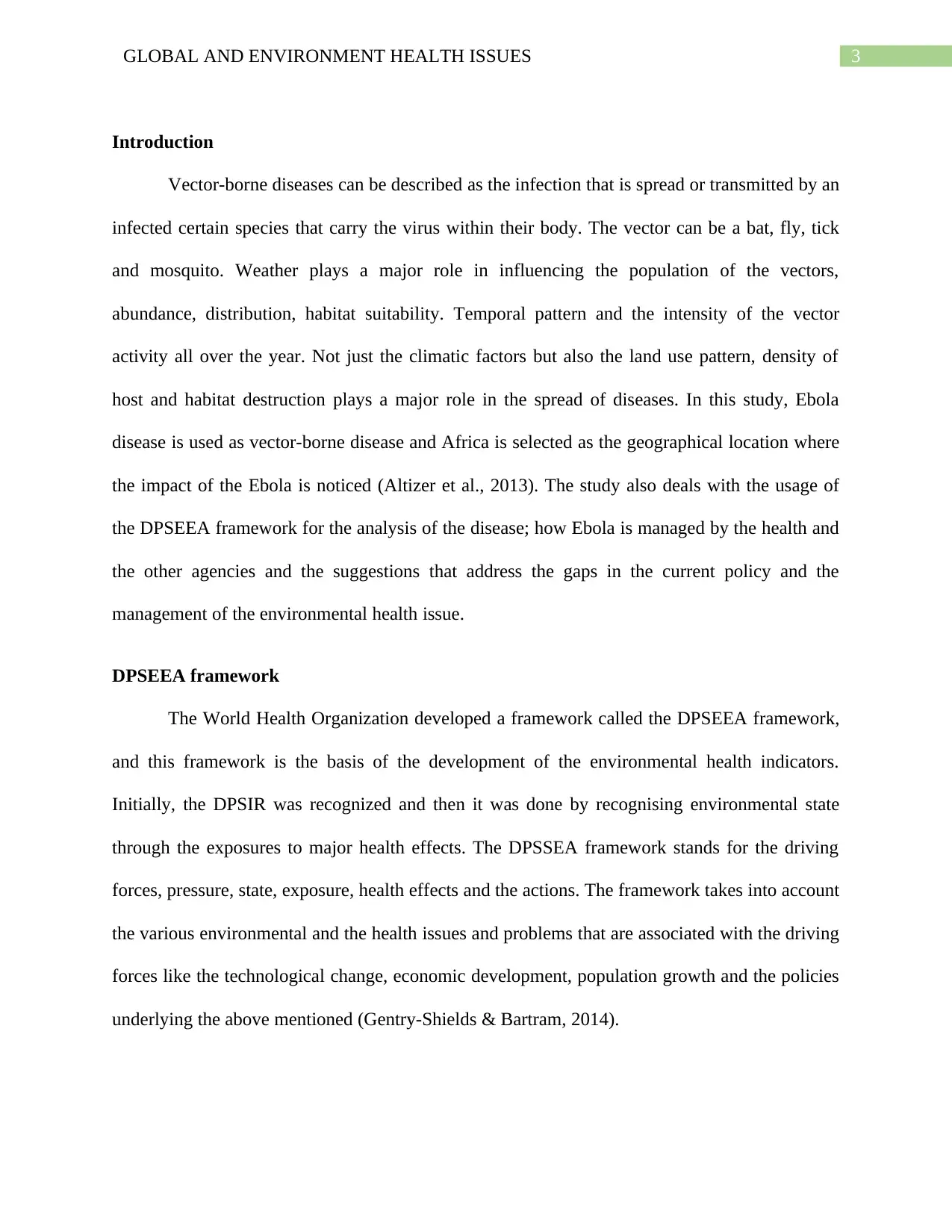
3GLOBAL AND ENVIRONMENT HEALTH ISSUES
Introduction
Vector-borne diseases can be described as the infection that is spread or transmitted by an
infected certain species that carry the virus within their body. The vector can be a bat, fly, tick
and mosquito. Weather plays a major role in influencing the population of the vectors,
abundance, distribution, habitat suitability. Temporal pattern and the intensity of the vector
activity all over the year. Not just the climatic factors but also the land use pattern, density of
host and habitat destruction plays a major role in the spread of diseases. In this study, Ebola
disease is used as vector-borne disease and Africa is selected as the geographical location where
the impact of the Ebola is noticed (Altizer et al., 2013). The study also deals with the usage of
the DPSEEA framework for the analysis of the disease; how Ebola is managed by the health and
the other agencies and the suggestions that address the gaps in the current policy and the
management of the environmental health issue.
DPSEEA framework
The World Health Organization developed a framework called the DPSEEA framework,
and this framework is the basis of the development of the environmental health indicators.
Initially, the DPSIR was recognized and then it was done by recognising environmental state
through the exposures to major health effects. The DPSSEA framework stands for the driving
forces, pressure, state, exposure, health effects and the actions. The framework takes into account
the various environmental and the health issues and problems that are associated with the driving
forces like the technological change, economic development, population growth and the policies
underlying the above mentioned (Gentry-Shields & Bartram, 2014).
Introduction
Vector-borne diseases can be described as the infection that is spread or transmitted by an
infected certain species that carry the virus within their body. The vector can be a bat, fly, tick
and mosquito. Weather plays a major role in influencing the population of the vectors,
abundance, distribution, habitat suitability. Temporal pattern and the intensity of the vector
activity all over the year. Not just the climatic factors but also the land use pattern, density of
host and habitat destruction plays a major role in the spread of diseases. In this study, Ebola
disease is used as vector-borne disease and Africa is selected as the geographical location where
the impact of the Ebola is noticed (Altizer et al., 2013). The study also deals with the usage of
the DPSEEA framework for the analysis of the disease; how Ebola is managed by the health and
the other agencies and the suggestions that address the gaps in the current policy and the
management of the environmental health issue.
DPSEEA framework
The World Health Organization developed a framework called the DPSEEA framework,
and this framework is the basis of the development of the environmental health indicators.
Initially, the DPSIR was recognized and then it was done by recognising environmental state
through the exposures to major health effects. The DPSSEA framework stands for the driving
forces, pressure, state, exposure, health effects and the actions. The framework takes into account
the various environmental and the health issues and problems that are associated with the driving
forces like the technological change, economic development, population growth and the policies
underlying the above mentioned (Gentry-Shields & Bartram, 2014).
Paraphrase This Document
Need a fresh take? Get an instant paraphrase of this document with our AI Paraphraser
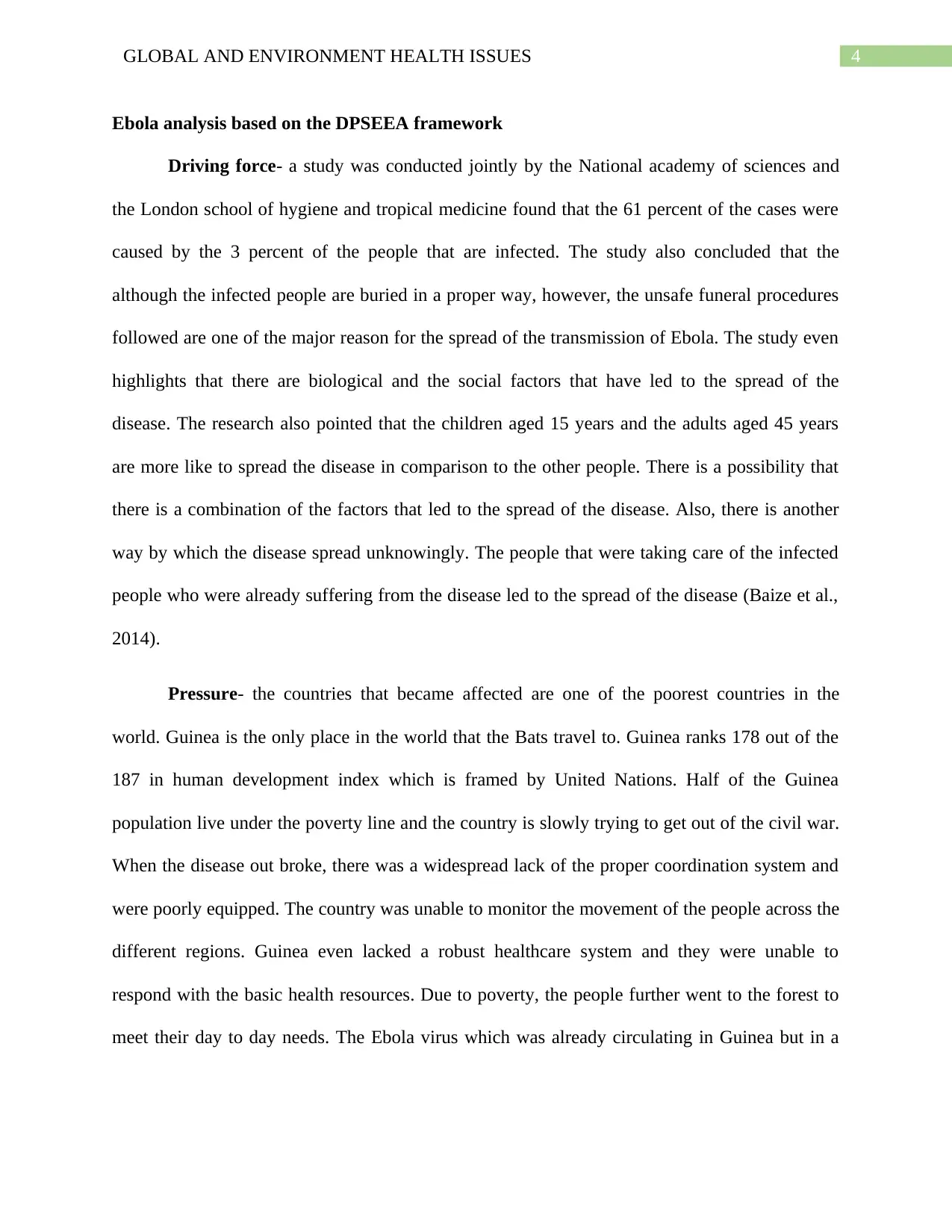
4GLOBAL AND ENVIRONMENT HEALTH ISSUES
Ebola analysis based on the DPSEEA framework
Driving force- a study was conducted jointly by the National academy of sciences and
the London school of hygiene and tropical medicine found that the 61 percent of the cases were
caused by the 3 percent of the people that are infected. The study also concluded that the
although the infected people are buried in a proper way, however, the unsafe funeral procedures
followed are one of the major reason for the spread of the transmission of Ebola. The study even
highlights that there are biological and the social factors that have led to the spread of the
disease. The research also pointed that the children aged 15 years and the adults aged 45 years
are more like to spread the disease in comparison to the other people. There is a possibility that
there is a combination of the factors that led to the spread of the disease. Also, there is another
way by which the disease spread unknowingly. The people that were taking care of the infected
people who were already suffering from the disease led to the spread of the disease (Baize et al.,
2014).
Pressure- the countries that became affected are one of the poorest countries in the
world. Guinea is the only place in the world that the Bats travel to. Guinea ranks 178 out of the
187 in human development index which is framed by United Nations. Half of the Guinea
population live under the poverty line and the country is slowly trying to get out of the civil war.
When the disease out broke, there was a widespread lack of the proper coordination system and
were poorly equipped. The country was unable to monitor the movement of the people across the
different regions. Guinea even lacked a robust healthcare system and they were unable to
respond with the basic health resources. Due to poverty, the people further went to the forest to
meet their day to day needs. The Ebola virus which was already circulating in Guinea but in a
Ebola analysis based on the DPSEEA framework
Driving force- a study was conducted jointly by the National academy of sciences and
the London school of hygiene and tropical medicine found that the 61 percent of the cases were
caused by the 3 percent of the people that are infected. The study also concluded that the
although the infected people are buried in a proper way, however, the unsafe funeral procedures
followed are one of the major reason for the spread of the transmission of Ebola. The study even
highlights that there are biological and the social factors that have led to the spread of the
disease. The research also pointed that the children aged 15 years and the adults aged 45 years
are more like to spread the disease in comparison to the other people. There is a possibility that
there is a combination of the factors that led to the spread of the disease. Also, there is another
way by which the disease spread unknowingly. The people that were taking care of the infected
people who were already suffering from the disease led to the spread of the disease (Baize et al.,
2014).
Pressure- the countries that became affected are one of the poorest countries in the
world. Guinea is the only place in the world that the Bats travel to. Guinea ranks 178 out of the
187 in human development index which is framed by United Nations. Half of the Guinea
population live under the poverty line and the country is slowly trying to get out of the civil war.
When the disease out broke, there was a widespread lack of the proper coordination system and
were poorly equipped. The country was unable to monitor the movement of the people across the
different regions. Guinea even lacked a robust healthcare system and they were unable to
respond with the basic health resources. Due to poverty, the people further went to the forest to
meet their day to day needs. The Ebola virus which was already circulating in Guinea but in a
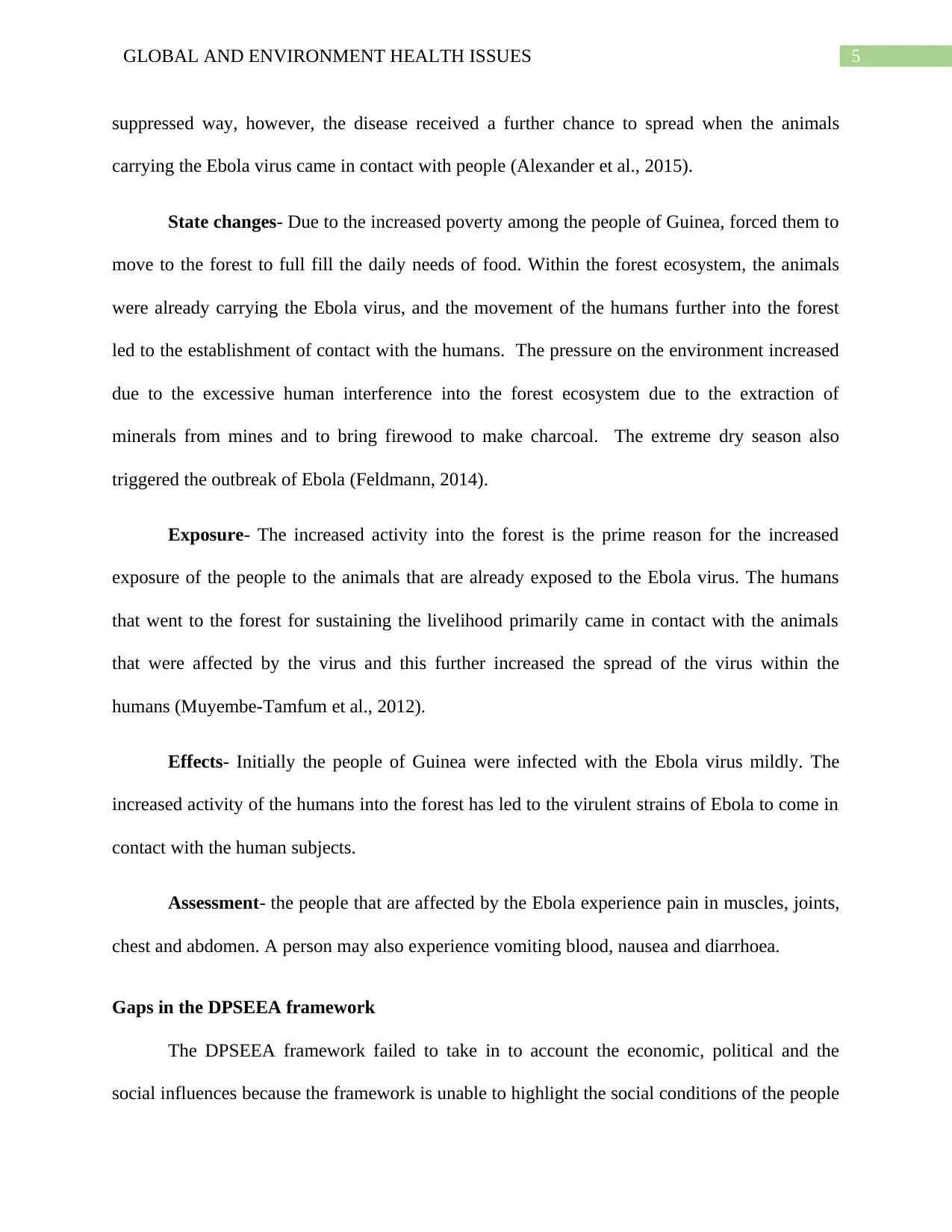
5GLOBAL AND ENVIRONMENT HEALTH ISSUES
suppressed way, however, the disease received a further chance to spread when the animals
carrying the Ebola virus came in contact with people (Alexander et al., 2015).
State changes- Due to the increased poverty among the people of Guinea, forced them to
move to the forest to full fill the daily needs of food. Within the forest ecosystem, the animals
were already carrying the Ebola virus, and the movement of the humans further into the forest
led to the establishment of contact with the humans. The pressure on the environment increased
due to the excessive human interference into the forest ecosystem due to the extraction of
minerals from mines and to bring firewood to make charcoal. The extreme dry season also
triggered the outbreak of Ebola (Feldmann, 2014).
Exposure- The increased activity into the forest is the prime reason for the increased
exposure of the people to the animals that are already exposed to the Ebola virus. The humans
that went to the forest for sustaining the livelihood primarily came in contact with the animals
that were affected by the virus and this further increased the spread of the virus within the
humans (Muyembe-Tamfum et al., 2012).
Effects- Initially the people of Guinea were infected with the Ebola virus mildly. The
increased activity of the humans into the forest has led to the virulent strains of Ebola to come in
contact with the human subjects.
Assessment- the people that are affected by the Ebola experience pain in muscles, joints,
chest and abdomen. A person may also experience vomiting blood, nausea and diarrhoea.
Gaps in the DPSEEA framework
The DPSEEA framework failed to take in to account the economic, political and the
social influences because the framework is unable to highlight the social conditions of the people
suppressed way, however, the disease received a further chance to spread when the animals
carrying the Ebola virus came in contact with people (Alexander et al., 2015).
State changes- Due to the increased poverty among the people of Guinea, forced them to
move to the forest to full fill the daily needs of food. Within the forest ecosystem, the animals
were already carrying the Ebola virus, and the movement of the humans further into the forest
led to the establishment of contact with the humans. The pressure on the environment increased
due to the excessive human interference into the forest ecosystem due to the extraction of
minerals from mines and to bring firewood to make charcoal. The extreme dry season also
triggered the outbreak of Ebola (Feldmann, 2014).
Exposure- The increased activity into the forest is the prime reason for the increased
exposure of the people to the animals that are already exposed to the Ebola virus. The humans
that went to the forest for sustaining the livelihood primarily came in contact with the animals
that were affected by the virus and this further increased the spread of the virus within the
humans (Muyembe-Tamfum et al., 2012).
Effects- Initially the people of Guinea were infected with the Ebola virus mildly. The
increased activity of the humans into the forest has led to the virulent strains of Ebola to come in
contact with the human subjects.
Assessment- the people that are affected by the Ebola experience pain in muscles, joints,
chest and abdomen. A person may also experience vomiting blood, nausea and diarrhoea.
Gaps in the DPSEEA framework
The DPSEEA framework failed to take in to account the economic, political and the
social influences because the framework is unable to highlight the social conditions of the people
⊘ This is a preview!⊘
Do you want full access?
Subscribe today to unlock all pages.

Trusted by 1+ million students worldwide
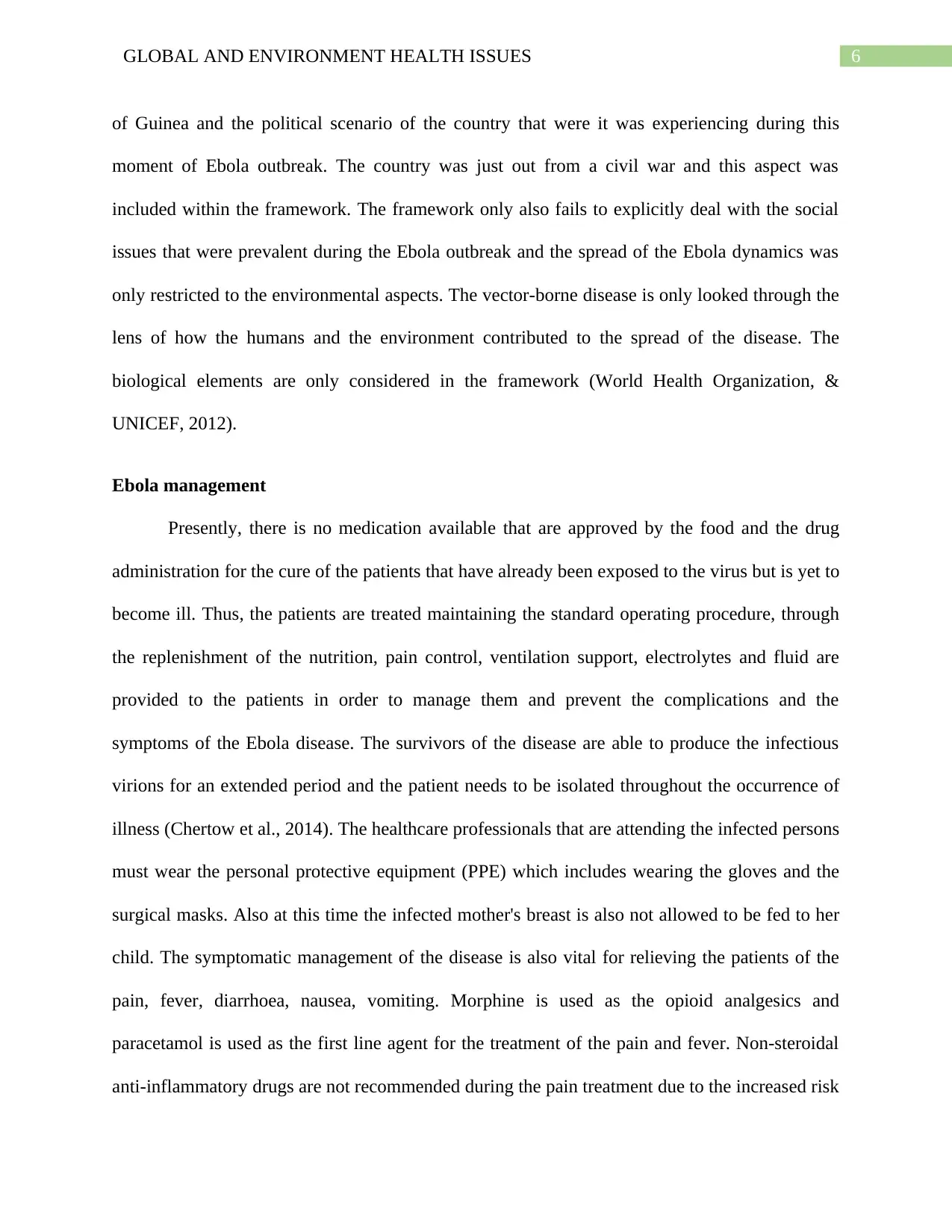
6GLOBAL AND ENVIRONMENT HEALTH ISSUES
of Guinea and the political scenario of the country that were it was experiencing during this
moment of Ebola outbreak. The country was just out from a civil war and this aspect was
included within the framework. The framework only also fails to explicitly deal with the social
issues that were prevalent during the Ebola outbreak and the spread of the Ebola dynamics was
only restricted to the environmental aspects. The vector-borne disease is only looked through the
lens of how the humans and the environment contributed to the spread of the disease. The
biological elements are only considered in the framework (World Health Organization, &
UNICEF, 2012).
Ebola management
Presently, there is no medication available that are approved by the food and the drug
administration for the cure of the patients that have already been exposed to the virus but is yet to
become ill. Thus, the patients are treated maintaining the standard operating procedure, through
the replenishment of the nutrition, pain control, ventilation support, electrolytes and fluid are
provided to the patients in order to manage them and prevent the complications and the
symptoms of the Ebola disease. The survivors of the disease are able to produce the infectious
virions for an extended period and the patient needs to be isolated throughout the occurrence of
illness (Chertow et al., 2014). The healthcare professionals that are attending the infected persons
must wear the personal protective equipment (PPE) which includes wearing the gloves and the
surgical masks. Also at this time the infected mother's breast is also not allowed to be fed to her
child. The symptomatic management of the disease is also vital for relieving the patients of the
pain, fever, diarrhoea, nausea, vomiting. Morphine is used as the opioid analgesics and
paracetamol is used as the first line agent for the treatment of the pain and fever. Non-steroidal
anti-inflammatory drugs are not recommended during the pain treatment due to the increased risk
of Guinea and the political scenario of the country that were it was experiencing during this
moment of Ebola outbreak. The country was just out from a civil war and this aspect was
included within the framework. The framework only also fails to explicitly deal with the social
issues that were prevalent during the Ebola outbreak and the spread of the Ebola dynamics was
only restricted to the environmental aspects. The vector-borne disease is only looked through the
lens of how the humans and the environment contributed to the spread of the disease. The
biological elements are only considered in the framework (World Health Organization, &
UNICEF, 2012).
Ebola management
Presently, there is no medication available that are approved by the food and the drug
administration for the cure of the patients that have already been exposed to the virus but is yet to
become ill. Thus, the patients are treated maintaining the standard operating procedure, through
the replenishment of the nutrition, pain control, ventilation support, electrolytes and fluid are
provided to the patients in order to manage them and prevent the complications and the
symptoms of the Ebola disease. The survivors of the disease are able to produce the infectious
virions for an extended period and the patient needs to be isolated throughout the occurrence of
illness (Chertow et al., 2014). The healthcare professionals that are attending the infected persons
must wear the personal protective equipment (PPE) which includes wearing the gloves and the
surgical masks. Also at this time the infected mother's breast is also not allowed to be fed to her
child. The symptomatic management of the disease is also vital for relieving the patients of the
pain, fever, diarrhoea, nausea, vomiting. Morphine is used as the opioid analgesics and
paracetamol is used as the first line agent for the treatment of the pain and fever. Non-steroidal
anti-inflammatory drugs are not recommended during the pain treatment due to the increased risk
Paraphrase This Document
Need a fresh take? Get an instant paraphrase of this document with our AI Paraphraser
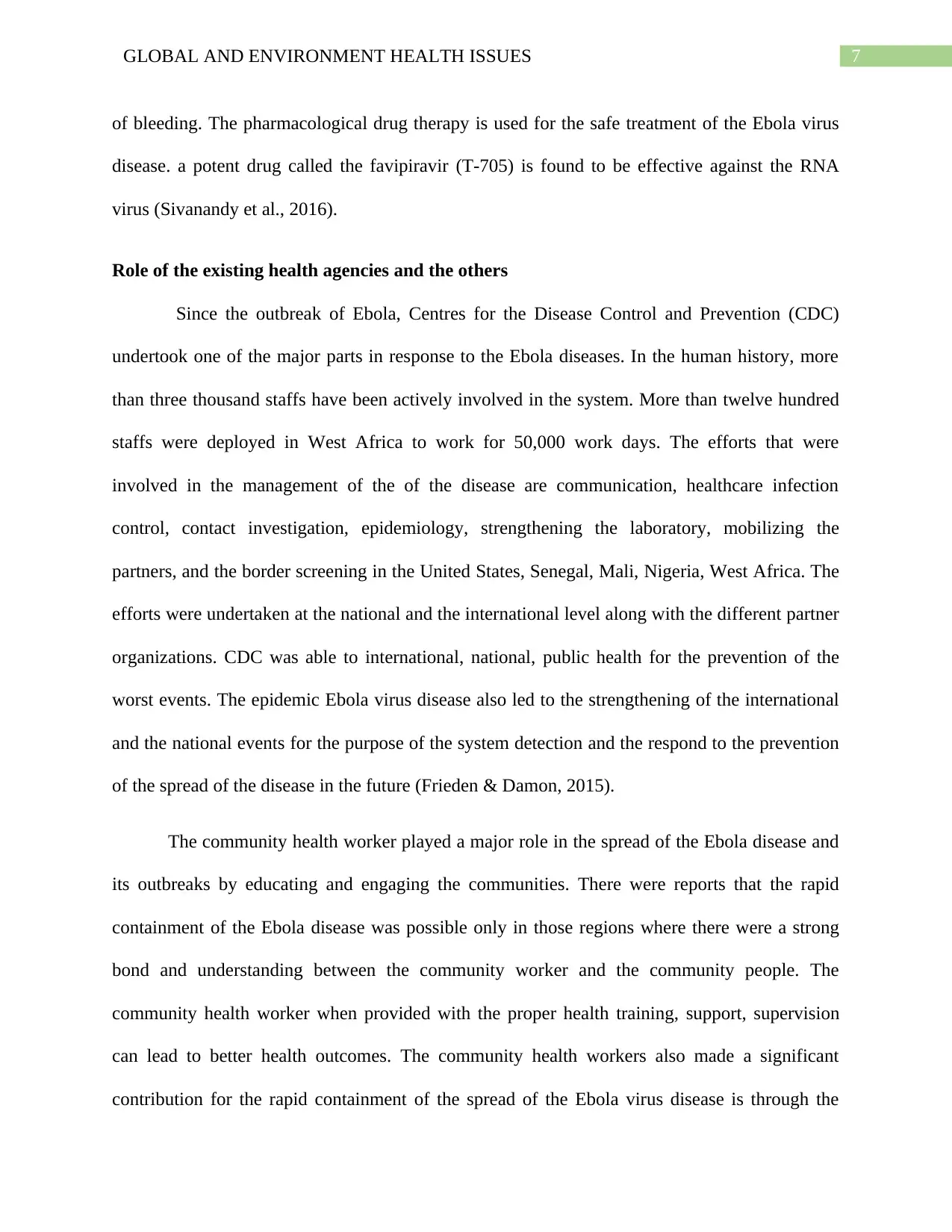
7GLOBAL AND ENVIRONMENT HEALTH ISSUES
of bleeding. The pharmacological drug therapy is used for the safe treatment of the Ebola virus
disease. a potent drug called the favipiravir (T-705) is found to be effective against the RNA
virus (Sivanandy et al., 2016).
Role of the existing health agencies and the others
Since the outbreak of Ebola, Centres for the Disease Control and Prevention (CDC)
undertook one of the major parts in response to the Ebola diseases. In the human history, more
than three thousand staffs have been actively involved in the system. More than twelve hundred
staffs were deployed in West Africa to work for 50,000 work days. The efforts that were
involved in the management of the of the disease are communication, healthcare infection
control, contact investigation, epidemiology, strengthening the laboratory, mobilizing the
partners, and the border screening in the United States, Senegal, Mali, Nigeria, West Africa. The
efforts were undertaken at the national and the international level along with the different partner
organizations. CDC was able to international, national, public health for the prevention of the
worst events. The epidemic Ebola virus disease also led to the strengthening of the international
and the national events for the purpose of the system detection and the respond to the prevention
of the spread of the disease in the future (Frieden & Damon, 2015).
The community health worker played a major role in the spread of the Ebola disease and
its outbreaks by educating and engaging the communities. There were reports that the rapid
containment of the Ebola disease was possible only in those regions where there were a strong
bond and understanding between the community worker and the community people. The
community health worker when provided with the proper health training, support, supervision
can lead to better health outcomes. The community health workers also made a significant
contribution for the rapid containment of the spread of the Ebola virus disease is through the
of bleeding. The pharmacological drug therapy is used for the safe treatment of the Ebola virus
disease. a potent drug called the favipiravir (T-705) is found to be effective against the RNA
virus (Sivanandy et al., 2016).
Role of the existing health agencies and the others
Since the outbreak of Ebola, Centres for the Disease Control and Prevention (CDC)
undertook one of the major parts in response to the Ebola diseases. In the human history, more
than three thousand staffs have been actively involved in the system. More than twelve hundred
staffs were deployed in West Africa to work for 50,000 work days. The efforts that were
involved in the management of the of the disease are communication, healthcare infection
control, contact investigation, epidemiology, strengthening the laboratory, mobilizing the
partners, and the border screening in the United States, Senegal, Mali, Nigeria, West Africa. The
efforts were undertaken at the national and the international level along with the different partner
organizations. CDC was able to international, national, public health for the prevention of the
worst events. The epidemic Ebola virus disease also led to the strengthening of the international
and the national events for the purpose of the system detection and the respond to the prevention
of the spread of the disease in the future (Frieden & Damon, 2015).
The community health worker played a major role in the spread of the Ebola disease and
its outbreaks by educating and engaging the communities. There were reports that the rapid
containment of the Ebola disease was possible only in those regions where there were a strong
bond and understanding between the community worker and the community people. The
community health worker when provided with the proper health training, support, supervision
can lead to better health outcomes. The community health workers also made a significant
contribution for the rapid containment of the spread of the Ebola virus disease is through the
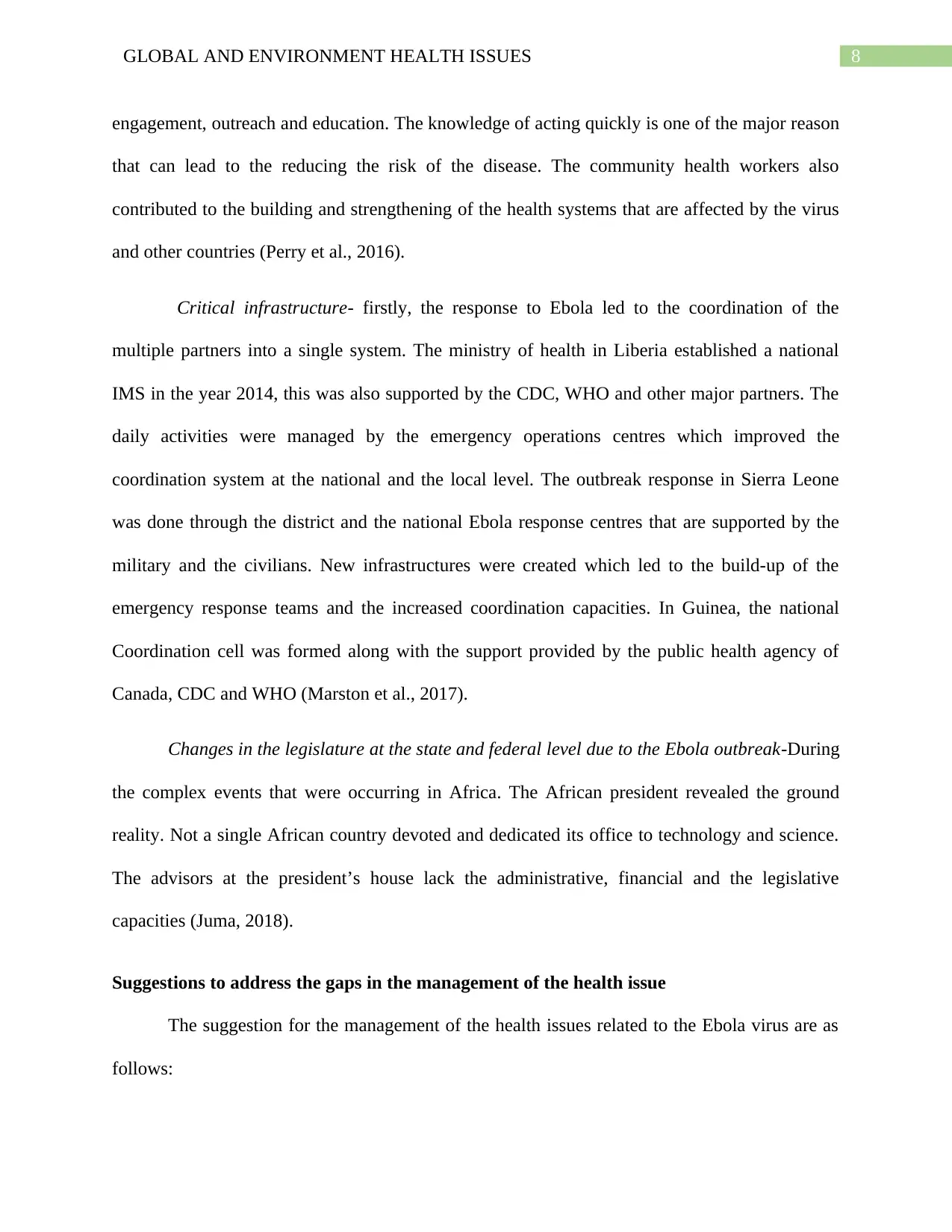
8GLOBAL AND ENVIRONMENT HEALTH ISSUES
engagement, outreach and education. The knowledge of acting quickly is one of the major reason
that can lead to the reducing the risk of the disease. The community health workers also
contributed to the building and strengthening of the health systems that are affected by the virus
and other countries (Perry et al., 2016).
Critical infrastructure- firstly, the response to Ebola led to the coordination of the
multiple partners into a single system. The ministry of health in Liberia established a national
IMS in the year 2014, this was also supported by the CDC, WHO and other major partners. The
daily activities were managed by the emergency operations centres which improved the
coordination system at the national and the local level. The outbreak response in Sierra Leone
was done through the district and the national Ebola response centres that are supported by the
military and the civilians. New infrastructures were created which led to the build-up of the
emergency response teams and the increased coordination capacities. In Guinea, the national
Coordination cell was formed along with the support provided by the public health agency of
Canada, CDC and WHO (Marston et al., 2017).
Changes in the legislature at the state and federal level due to the Ebola outbreak-During
the complex events that were occurring in Africa. The African president revealed the ground
reality. Not a single African country devoted and dedicated its office to technology and science.
The advisors at the president’s house lack the administrative, financial and the legislative
capacities (Juma, 2018).
Suggestions to address the gaps in the management of the health issue
The suggestion for the management of the health issues related to the Ebola virus are as
follows:
engagement, outreach and education. The knowledge of acting quickly is one of the major reason
that can lead to the reducing the risk of the disease. The community health workers also
contributed to the building and strengthening of the health systems that are affected by the virus
and other countries (Perry et al., 2016).
Critical infrastructure- firstly, the response to Ebola led to the coordination of the
multiple partners into a single system. The ministry of health in Liberia established a national
IMS in the year 2014, this was also supported by the CDC, WHO and other major partners. The
daily activities were managed by the emergency operations centres which improved the
coordination system at the national and the local level. The outbreak response in Sierra Leone
was done through the district and the national Ebola response centres that are supported by the
military and the civilians. New infrastructures were created which led to the build-up of the
emergency response teams and the increased coordination capacities. In Guinea, the national
Coordination cell was formed along with the support provided by the public health agency of
Canada, CDC and WHO (Marston et al., 2017).
Changes in the legislature at the state and federal level due to the Ebola outbreak-During
the complex events that were occurring in Africa. The African president revealed the ground
reality. Not a single African country devoted and dedicated its office to technology and science.
The advisors at the president’s house lack the administrative, financial and the legislative
capacities (Juma, 2018).
Suggestions to address the gaps in the management of the health issue
The suggestion for the management of the health issues related to the Ebola virus are as
follows:
⊘ This is a preview!⊘
Do you want full access?
Subscribe today to unlock all pages.

Trusted by 1+ million students worldwide
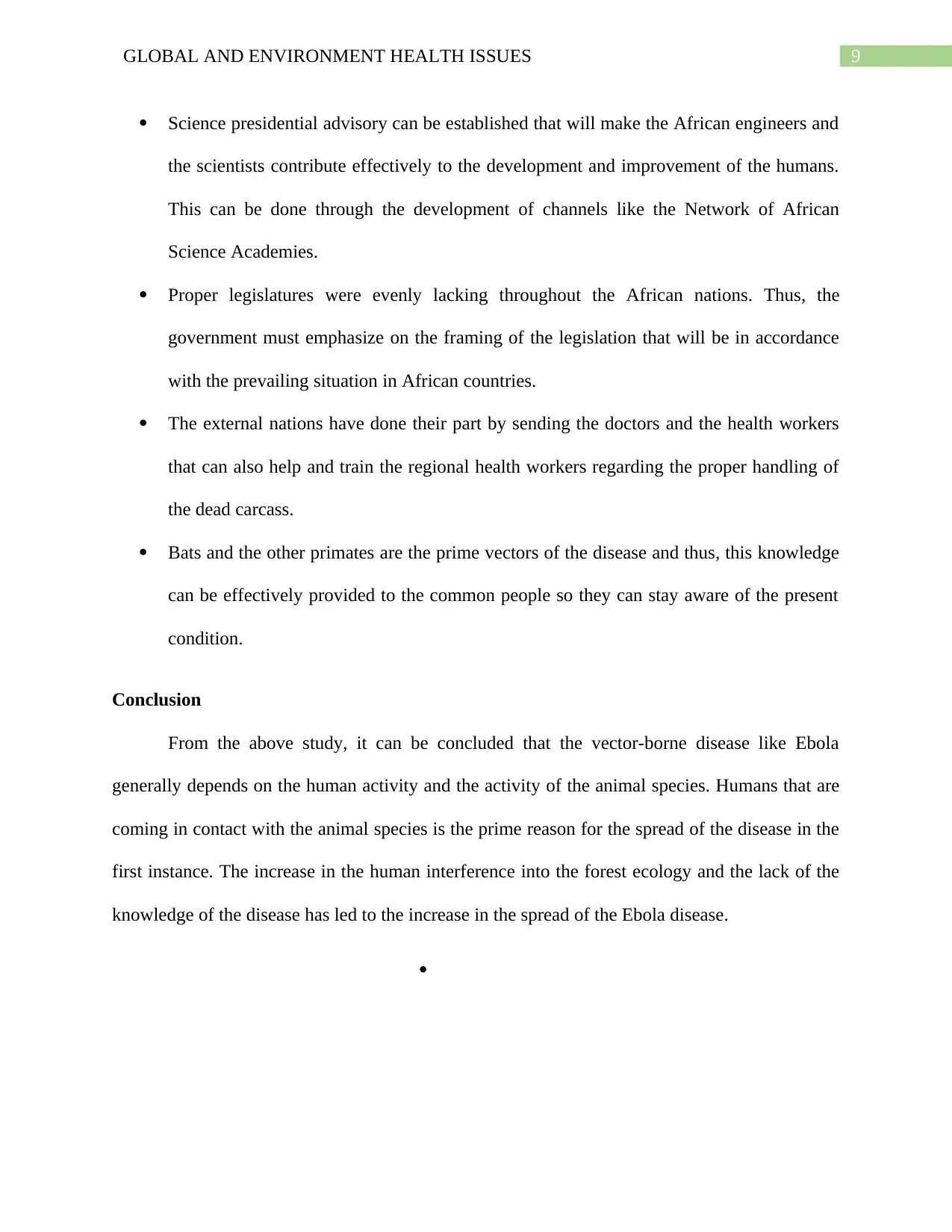
9GLOBAL AND ENVIRONMENT HEALTH ISSUES
Science presidential advisory can be established that will make the African engineers and
the scientists contribute effectively to the development and improvement of the humans.
This can be done through the development of channels like the Network of African
Science Academies.
Proper legislatures were evenly lacking throughout the African nations. Thus, the
government must emphasize on the framing of the legislation that will be in accordance
with the prevailing situation in African countries.
The external nations have done their part by sending the doctors and the health workers
that can also help and train the regional health workers regarding the proper handling of
the dead carcass.
Bats and the other primates are the prime vectors of the disease and thus, this knowledge
can be effectively provided to the common people so they can stay aware of the present
condition.
Conclusion
From the above study, it can be concluded that the vector-borne disease like Ebola
generally depends on the human activity and the activity of the animal species. Humans that are
coming in contact with the animal species is the prime reason for the spread of the disease in the
first instance. The increase in the human interference into the forest ecology and the lack of the
knowledge of the disease has led to the increase in the spread of the Ebola disease.
Science presidential advisory can be established that will make the African engineers and
the scientists contribute effectively to the development and improvement of the humans.
This can be done through the development of channels like the Network of African
Science Academies.
Proper legislatures were evenly lacking throughout the African nations. Thus, the
government must emphasize on the framing of the legislation that will be in accordance
with the prevailing situation in African countries.
The external nations have done their part by sending the doctors and the health workers
that can also help and train the regional health workers regarding the proper handling of
the dead carcass.
Bats and the other primates are the prime vectors of the disease and thus, this knowledge
can be effectively provided to the common people so they can stay aware of the present
condition.
Conclusion
From the above study, it can be concluded that the vector-borne disease like Ebola
generally depends on the human activity and the activity of the animal species. Humans that are
coming in contact with the animal species is the prime reason for the spread of the disease in the
first instance. The increase in the human interference into the forest ecology and the lack of the
knowledge of the disease has led to the increase in the spread of the Ebola disease.
Paraphrase This Document
Need a fresh take? Get an instant paraphrase of this document with our AI Paraphraser
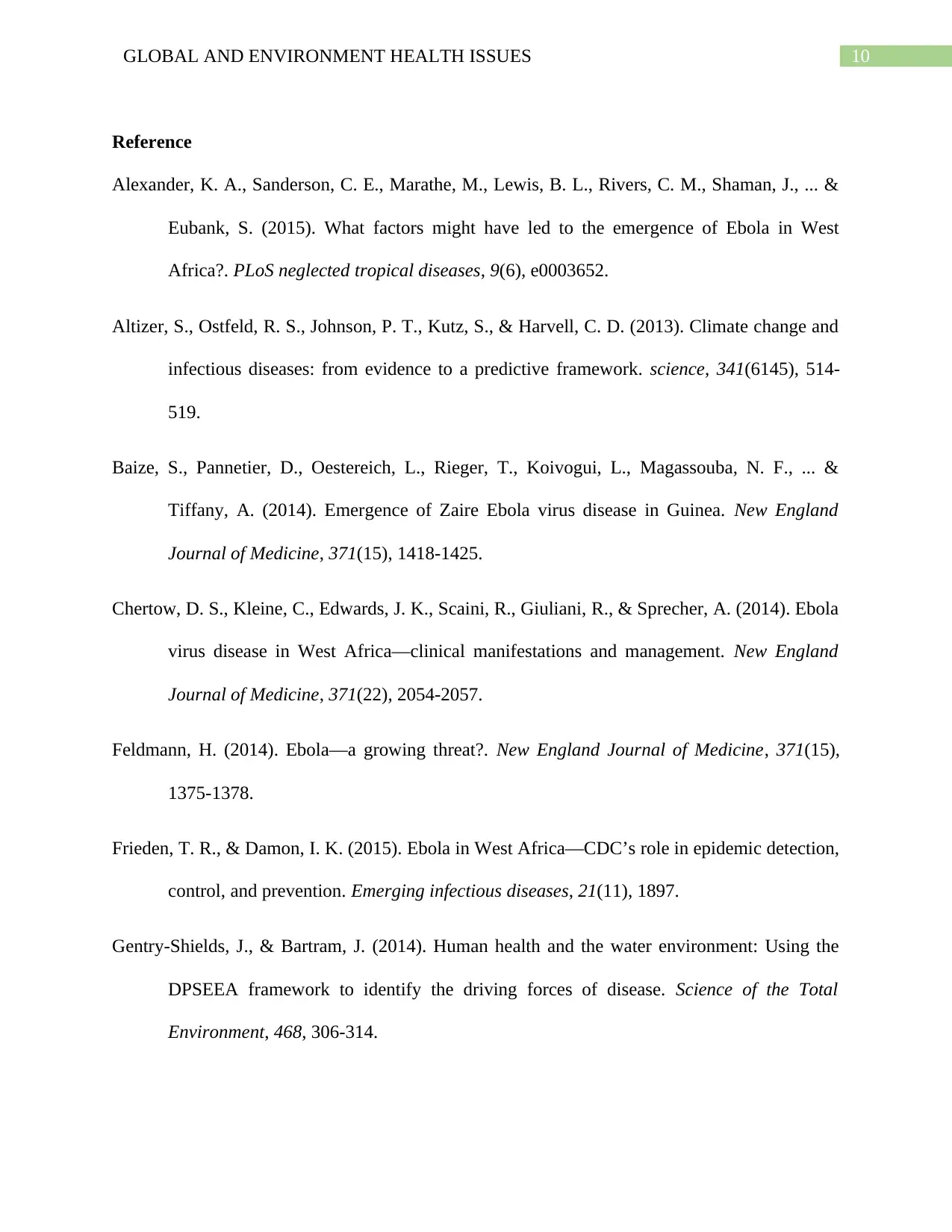
10GLOBAL AND ENVIRONMENT HEALTH ISSUES
Reference
Alexander, K. A., Sanderson, C. E., Marathe, M., Lewis, B. L., Rivers, C. M., Shaman, J., ... &
Eubank, S. (2015). What factors might have led to the emergence of Ebola in West
Africa?. PLoS neglected tropical diseases, 9(6), e0003652.
Altizer, S., Ostfeld, R. S., Johnson, P. T., Kutz, S., & Harvell, C. D. (2013). Climate change and
infectious diseases: from evidence to a predictive framework. science, 341(6145), 514-
519.
Baize, S., Pannetier, D., Oestereich, L., Rieger, T., Koivogui, L., Magassouba, N. F., ... &
Tiffany, A. (2014). Emergence of Zaire Ebola virus disease in Guinea. New England
Journal of Medicine, 371(15), 1418-1425.
Chertow, D. S., Kleine, C., Edwards, J. K., Scaini, R., Giuliani, R., & Sprecher, A. (2014). Ebola
virus disease in West Africa—clinical manifestations and management. New England
Journal of Medicine, 371(22), 2054-2057.
Feldmann, H. (2014). Ebola—a growing threat?. New England Journal of Medicine, 371(15),
1375-1378.
Frieden, T. R., & Damon, I. K. (2015). Ebola in West Africa—CDC’s role in epidemic detection,
control, and prevention. Emerging infectious diseases, 21(11), 1897.
Gentry-Shields, J., & Bartram, J. (2014). Human health and the water environment: Using the
DPSEEA framework to identify the driving forces of disease. Science of the Total
Environment, 468, 306-314.
Reference
Alexander, K. A., Sanderson, C. E., Marathe, M., Lewis, B. L., Rivers, C. M., Shaman, J., ... &
Eubank, S. (2015). What factors might have led to the emergence of Ebola in West
Africa?. PLoS neglected tropical diseases, 9(6), e0003652.
Altizer, S., Ostfeld, R. S., Johnson, P. T., Kutz, S., & Harvell, C. D. (2013). Climate change and
infectious diseases: from evidence to a predictive framework. science, 341(6145), 514-
519.
Baize, S., Pannetier, D., Oestereich, L., Rieger, T., Koivogui, L., Magassouba, N. F., ... &
Tiffany, A. (2014). Emergence of Zaire Ebola virus disease in Guinea. New England
Journal of Medicine, 371(15), 1418-1425.
Chertow, D. S., Kleine, C., Edwards, J. K., Scaini, R., Giuliani, R., & Sprecher, A. (2014). Ebola
virus disease in West Africa—clinical manifestations and management. New England
Journal of Medicine, 371(22), 2054-2057.
Feldmann, H. (2014). Ebola—a growing threat?. New England Journal of Medicine, 371(15),
1375-1378.
Frieden, T. R., & Damon, I. K. (2015). Ebola in West Africa—CDC’s role in epidemic detection,
control, and prevention. Emerging infectious diseases, 21(11), 1897.
Gentry-Shields, J., & Bartram, J. (2014). Human health and the water environment: Using the
DPSEEA framework to identify the driving forces of disease. Science of the Total
Environment, 468, 306-314.
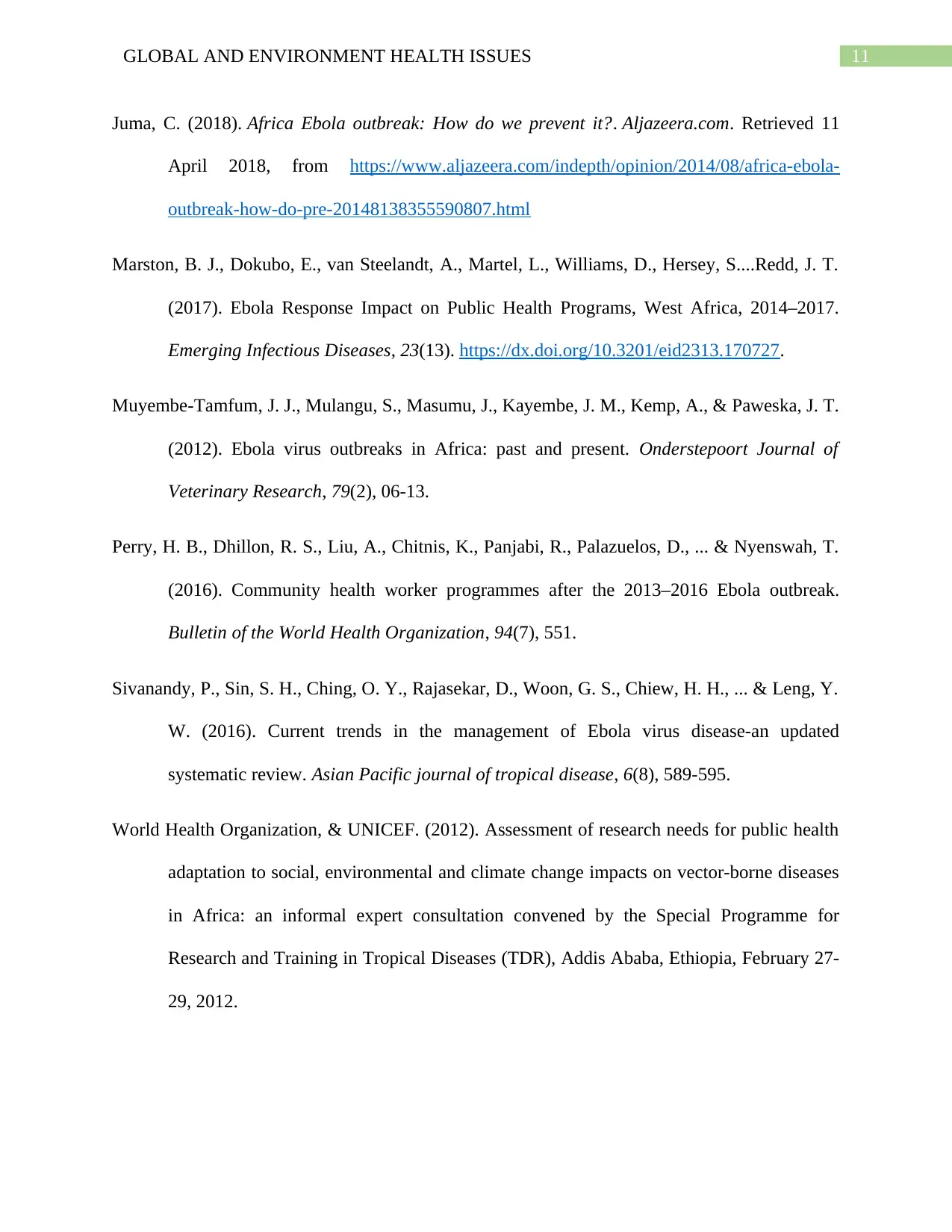
11GLOBAL AND ENVIRONMENT HEALTH ISSUES
Juma, C. (2018). Africa Ebola outbreak: How do we prevent it?. Aljazeera.com. Retrieved 11
April 2018, from https://www.aljazeera.com/indepth/opinion/2014/08/africa-ebola-
outbreak-how-do-pre-20148138355590807.html
Marston, B. J., Dokubo, E., van Steelandt, A., Martel, L., Williams, D., Hersey, S....Redd, J. T.
(2017). Ebola Response Impact on Public Health Programs, West Africa, 2014–2017.
Emerging Infectious Diseases, 23(13). https://dx.doi.org/10.3201/eid2313.170727.
Muyembe-Tamfum, J. J., Mulangu, S., Masumu, J., Kayembe, J. M., Kemp, A., & Paweska, J. T.
(2012). Ebola virus outbreaks in Africa: past and present. Onderstepoort Journal of
Veterinary Research, 79(2), 06-13.
Perry, H. B., Dhillon, R. S., Liu, A., Chitnis, K., Panjabi, R., Palazuelos, D., ... & Nyenswah, T.
(2016). Community health worker programmes after the 2013–2016 Ebola outbreak.
Bulletin of the World Health Organization, 94(7), 551.
Sivanandy, P., Sin, S. H., Ching, O. Y., Rajasekar, D., Woon, G. S., Chiew, H. H., ... & Leng, Y.
W. (2016). Current trends in the management of Ebola virus disease-an updated
systematic review. Asian Pacific journal of tropical disease, 6(8), 589-595.
World Health Organization, & UNICEF. (2012). Assessment of research needs for public health
adaptation to social, environmental and climate change impacts on vector-borne diseases
in Africa: an informal expert consultation convened by the Special Programme for
Research and Training in Tropical Diseases (TDR), Addis Ababa, Ethiopia, February 27-
29, 2012.
Juma, C. (2018). Africa Ebola outbreak: How do we prevent it?. Aljazeera.com. Retrieved 11
April 2018, from https://www.aljazeera.com/indepth/opinion/2014/08/africa-ebola-
outbreak-how-do-pre-20148138355590807.html
Marston, B. J., Dokubo, E., van Steelandt, A., Martel, L., Williams, D., Hersey, S....Redd, J. T.
(2017). Ebola Response Impact on Public Health Programs, West Africa, 2014–2017.
Emerging Infectious Diseases, 23(13). https://dx.doi.org/10.3201/eid2313.170727.
Muyembe-Tamfum, J. J., Mulangu, S., Masumu, J., Kayembe, J. M., Kemp, A., & Paweska, J. T.
(2012). Ebola virus outbreaks in Africa: past and present. Onderstepoort Journal of
Veterinary Research, 79(2), 06-13.
Perry, H. B., Dhillon, R. S., Liu, A., Chitnis, K., Panjabi, R., Palazuelos, D., ... & Nyenswah, T.
(2016). Community health worker programmes after the 2013–2016 Ebola outbreak.
Bulletin of the World Health Organization, 94(7), 551.
Sivanandy, P., Sin, S. H., Ching, O. Y., Rajasekar, D., Woon, G. S., Chiew, H. H., ... & Leng, Y.
W. (2016). Current trends in the management of Ebola virus disease-an updated
systematic review. Asian Pacific journal of tropical disease, 6(8), 589-595.
World Health Organization, & UNICEF. (2012). Assessment of research needs for public health
adaptation to social, environmental and climate change impacts on vector-borne diseases
in Africa: an informal expert consultation convened by the Special Programme for
Research and Training in Tropical Diseases (TDR), Addis Ababa, Ethiopia, February 27-
29, 2012.
⊘ This is a preview!⊘
Do you want full access?
Subscribe today to unlock all pages.

Trusted by 1+ million students worldwide
1 out of 12
Related Documents
Your All-in-One AI-Powered Toolkit for Academic Success.
+13062052269
info@desklib.com
Available 24*7 on WhatsApp / Email
![[object Object]](/_next/static/media/star-bottom.7253800d.svg)
Unlock your academic potential
Copyright © 2020–2025 A2Z Services. All Rights Reserved. Developed and managed by ZUCOL.





